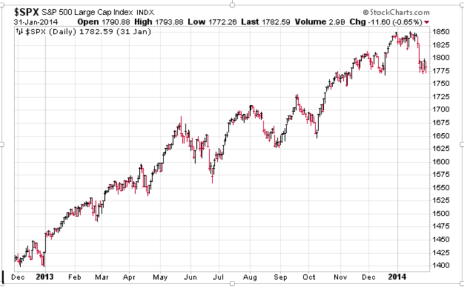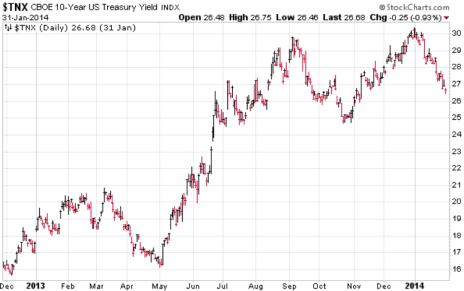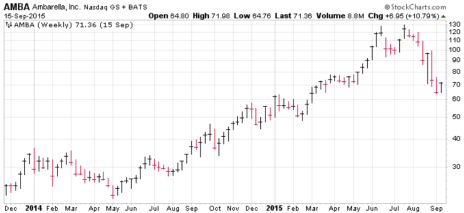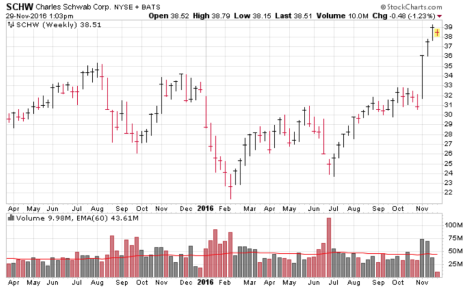Rising Interest Rates Are Usually GOOD for Stocks
One of the biggest hurdles most investors (from novices to professionals) have to overcome in the market is the acceptance of the market’s “standard wisdom,” a phrase that I’m using as a catch-all for the many widely accepted market-isms you hear from market pundits.
These pieces of wisdom are accepted mostly because they make sense. For instance: Buy Low and Sell High. Who can argue with that? And there’s also: You Never Go Broke Taking a Profit. It’s hard to argue with that either.
Unfortunately, because the stock market is a contrary animal, some of these truisms aren’t so true, no matter how good they sound or how much common sense they seem to possess. And I’m seeing a couple of these market-isms talked about a lot recently, namely, that rising interest rates will be a headwind for the market, and the market has come so far so fast that a retreat is inevitable. Neither seems true to me, and here’s why.
Since the election, it’s no secret that Treasury rates have pushed higher. Actually, the 10-year Treasury yield bottomed right after Brexit at 1.34% and was up to 1.86% by Election Day. Since then, it’s spiked as high as 2.42%!




Low rates have supposedly helped the market for the past few years, so many investors now see the new uptrend in rates (along with anticipated Fed rate hikes starting this month) and think it will provide a major headwind. It makes sense, right?
Well, it turns out that—at least for the initial few months of a rally—rising interest rates often confirm the market’s strength! And (at the risk of sounding like an economist) that’s because rising interest rates initially signal the market’s anticipation of faster economic growth (especially when combined with weak gold prices and a strong U.S. dollar).
In fact, the three biggest bull moves of the past 15 years all occurred amid rising interest rates. In 2003, as a new bull market kicked off, the 10-year yield rose from 3.07% to 4.67% in just three months! They rose a bit further during the next few months, but that didn’t stop the stock market from going bananas.
In 2009, rates actually bottomed at 2.04% before doubling by the middle of 2009. Of course, stocks soared all year following the recovery from the mega-bear market.
And in 2013, when the S&P 500 rose 30%, we saw the 10-year yield move from 1.75% to 3.04%! (See below.)
Obviously, at some point, if rates rise for a couple of years and the Fed gets too tight, the market and economy will suffer. But the recent increase in interest rates is likely more of a bullish confirmation of the stock market’s strength and not something you should worry about.
Is Your Stock Extended or Blasting Off?
The other piece of “standard wisdom” is that the market’s recent strength will lead to a pullback as the post-election fervor cools. This comes down to the old theory of overbought—i.e., the market has come too far too fast, so it needs to consolidate for a bit.
The trick with overbought (and oversold for that matter) is that most of the time, it’s worth paying attention to—a stock or market that has a huge run over a short period of time usually retreats and consolidates for a while afterwards.
However, the key is knowing the difference between two types of overbought: Climax Action (which usually occurs near major tops) and Kickoff Action (which usually occurs near the start of a major run). They look the same as the market goes straight up for two or three weeks, but the difference is when the action occurs within a stock’s overall run.
Climax Action occurs after many months of uptrending prices, usually when many investors are excited about the market (or a particular stock). A classic example was Ambarella (AMBA), which broke out at 34 in August 2014, ran to 80 by the spring of 2015, and then, after that surge, exploded to 128 in just a few weeks. That was a climax top; even today, the stock is about half of what it was at that top.
Kickoffs, on the other hand, usually occur after long periods of no progress and are a sign of strength. In my opinion, that’s just what we’re seeing now—the major indexes have leapt out of a two-year sideways period since the presidential election, so the straight-up action since then is a sign of a sudden, positive change in investor perception, something that usually portends future gains.
Frankly, in my universe of growth stocks, I’m not seeing that type of straight-up action (at least not yet). Most of the names I’m watching are still setting up and building launching pads. But there’s lots of kickoff action in sectors like financials.
A Big-Cap Financial Stock To Buy
One financial stock that looks great here (and still has some solid growth numbers) is Charles Schwab (SCHW), which I wrote about two weeks ago in Cabot Top Ten Trader:
“The Charles Schwab Corporation is a familiar name among traders given that it provides wealth management, brokerage, money management, banking and financial advisory services. It’s been a well-respected firm for years, despite the stock’s poor performance in 2015 amid a tough industry backdrop. Analysts have generally been positive on the company’s long-term growth prospects. That enthusiasm began to boil to the surface this summer as Schwab surpassed 10 million active brokerage accounts (these are real accounts, not like the ones at rival Wells Fargo). It also became evident that Schwab would complete a fifth consecutive year of landing $100 billion in net new assets. Management was already out on the road talking about how it planned to keep up double-digit revenue growth when interest rates crept higher, and speculation of a more accommodative regulatory environment post-election has only helped them to sell that message. Speculation has also been rising that Schwab is looking to buy small cap LPL Financial (LPLA), which has valuable financial and strategic assets that could be incredibly attractive to a larger acquirer with scale. We don’t have a strong opinion on the acquisition potential but would note that Schwab, with a market cap of $50 billion, is a solid play with or without LPL Financial, as earnings are estimated to rise 20% next year on its own.”
As you can see in the chart above, SCHW built a big base from August 2015 right through Election Day—15 long months of sideways-to-down action that surely wore out most investors. But the explosion higher since then looks like a kickoff to me—pullbacks of a couple of points are always possible, but my guess is that retreats will be either brief, shallow or both for the next few weeks.





